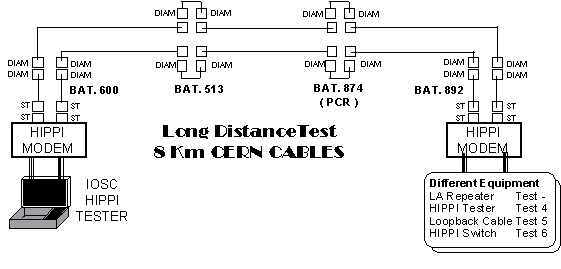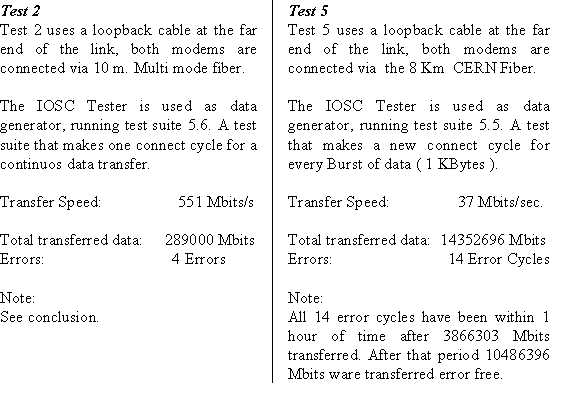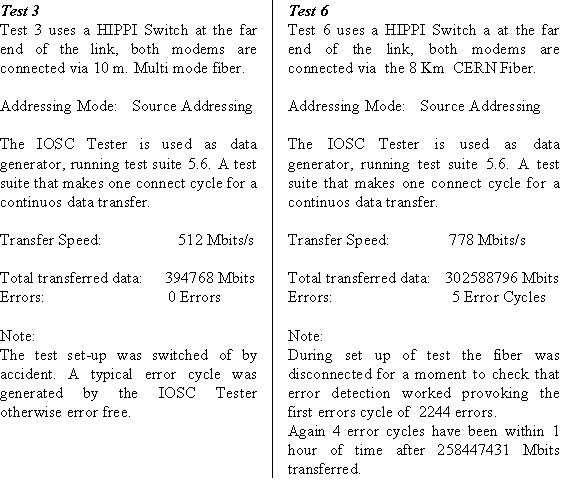![]()

Arie Van Praag, CERN division ECP, 18 October, 1994
Serial HIPPI is not an ANSI standard, it is now however a well established product that is used in a number of places. It allows point to point computer connections with the same bandwidth as cable connected HIPPI but it extends the maximum distance up to 10 Km. Specification is given in "Serial-HIPPI Specification Revision 1.2" April 5 1993.
*) To guaranty interconnectivity the plug in boards for all three switches are made in close collaboration with BCP.
For Lab test the BCP HIPPI Modems where coupled with 10 m Multi Mode fibers. ( Fig 1 )

Fig 1: Lab test Configuration ST = ST Connectors
For the long distance tests existing Single Mode fibers between Building 600 and Building 892 ware used ( fig 1 ). The Total distance is 8 Km and the 2 Single Mode fibers made available for this test measured the following overall attenuation:


Fig 2: Fibers, Connectors and Patch cords used for the Long Distance Tests. DIAM = Diamond Connector, ST = ST connector
The two combinations of tests 2 and 5 and of test 3 and 6 are analyzed pair wise, because both pairs compare an identical set-up, with short Multi Mode Fibers and with the 8 Km of CERN Fiber.

It should also be noted that the IOSC HIPPI Tester generates a certain number of errors if halted. Such that the corresponding last line in the "error log file" is not taken in account.
Test 2 and Test 5 use both a loopback cable to interconnect Source and Destination at the far end. This implies that the HIPPI clock recovered from the link by a Phase- Lock-Loop (PLL) is returned in an other PLL without resynchronisation in an outside device. This will increment the clock jitter and as such is a potential source for errors.
First conclusion in the results from test 5 is that errors arrive in groups. In fact a single error will generate a high error number because of the data stored in 16 Km of fiber. No errors are detected for the first 3.86 Tbits of data and than 14 error cycles can be seen in a 1 hour distance, followed by an error free transfer of > 10 Tbits. I suspected already highly that something had happened to the mains supply, suspicion that was confirmed later. The same criteria concerning the PLL's are valid, and the error rate stays in the same values as test 2.

Test 6 was halted at 5 September 9:00. Also in this test a number of error cycles is found after a relatively long time of error free operation. Collecting the equipment at the far end of the link shortly after 9 H -, we found somebody working in the fiber room. On our questions it turned out that the man had started the day before around 12 H- and had used electrical apparatus. This proved my suspicion that a certain sensibility for noise on the 220 V mains supply played a roll in this tests. Nevertheless 258 Tbits of data have been send before the first explained error occurred. showing an error rate better than the error rate of 1. 10 -14 specified by the manufacturer. Time wise this corresponds to 1 error cycle a week at the full HIPPI bandwidth of 800 Mbits/sec.
The HIPPI modems, compliant to the Serial HIPPI adhock standard, worked perfectly well to what could be expected. And transferred 200 to 300 Tbits of data without errors. This corresponds perfectly well with the Bit Error Rate of 10 -14 given by the manufacturer. It can be concluded that Serial HIPPI, either using separate HIPPI Modems, or as part of a HIPPI switch, are perfectly capable to send data from experiments, at high speed, to points up to 10 Km away. For example from the CERN North area to the computer center in Building 513. However a certain sensibility was detected for noise on the 220 V mains supply. For the moment the problem can be solved with line stabilizers but I strongly recommend the manufacturer to look at this problem using a 50 Hz 220 - 230 power supply.
The author thanks Jim Breitmeyer from BCP and Peter Bura from Laser 2000 ( the European represent of BCP ) for making the HIPPI modems available for this tests. I also have to thank Patrick Donnat from CERN for preparing the long distance Fiber Connections and helping me to set up the Tests.
1 ERRORS / 97000 Mbits @ 08-25-1994 16:45:00
2 ERRORS / 110000 Mbits @ 08-25-1994 16:46:43
3 ERRORS / 145000 Mbits @ 08-26-1994 10:30:00
4 ERRORS / 158000 Mbits @ 08-26-1994 17:15:00
7 ERRORS / 289000 Mbits @ 08-27-1994 12:19:00
0 ERRORS / 291 Mbits @ 09-19-1994 07:17:43
9309 ERRORS / 3866303 Mbits @ 09-20-1994 12:10:00
14963 ERRORS / 3866303 Mbits @ 09-20-1994 12:10:08
24215 ERRORS / 3866303 Mbits @ 09-20-1994 12:44:56
26039 ERRORS / 3874777 Mbits @ 09-20-1994 12:48:44
11334 ERRORS / 3874792 Mbits @ 09-20-1994 12:48:45
48514 ERRORS / 3874830 Mbits @ 09-20-1994 12:53:45
41614 ERRORS / 3874865 Mbits @ 09-20-1994 12:53:46
56527 ERRORS / 3876354 Mbits @ 09-20-1994 12:54:25
57104 ERRORS / 3879200 Mbits @ 09-20-1994 12:54:29
61002 ERRORS / 3879208 Mbits @ 09-20-1994 12:56:57
64210 ERRORS / 3883870 Mbits @ 09-20-1994 12:57:39
46900 ERRORS / 3883894 Mbits @ 09-20-1994 12:57:55
53229 ERRORS / 3893312 Mbits @ 09-20-1994 13:02:08
59342 ERRORS / 3893345 Mbits @ 09-20-1994 13:02:11
59343 ERRORS /14352696 Mbits @ 09-23-1994 17:20:39
"Restart"
0 ERRORS / 305284 Mbits @ 09-05-1994 10:59:30
"Reset Error Counter"
0 ERRORS / 32484 Mbits @ 09-30-1994 15:59:30
"258 Tbits until first error"
115 ERRORS / 258447431 Mbits @ 10-04-1994 12:13:23
"Somebody started to work in the fiber room at 12 H and 8 H next morning"
116 ERRORS / 300393900 Mbits @ 10-05-1994 08:04:03
117 ERRORS / 300892592 Mbits @ 10-05-1994 08:14:44
119 ERRORS / 301414374 Mbits @ 10-05-1994 08:25:54
121 ERRORS / 302177037 Mbits @ 10-05-1994 08:42:14
267 ERRORS / 302588796 Mbits @ 10-05-1994 08:51:04
![]()
This is one of the CERN High Speed Interconnect pages - 7 July 1995 - Arie van Praag